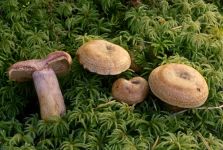Habitat: It occurs in a variety of habitats and seems to associate primarily with pines and Douglas-fir, especially in younger stands.
Conservation Status: Not of concern
Lactarius rubrilacteus is related to the L. deliciosus group but differs by the light orange to brownish orange, obscurely to distinctly zonate cap which often is broadly vase-shaped when mature, the light orange to grayish orange gills, and a light orange to brownish orange or somewhat reddish stipe, which often has a whitish bloom at first and develops distinct spots when mature. The latex is reddish brown and does not change color on exposure, however, bruised, damaged or aged mushrooms often have grayish to greenish colors, and sometimes even unexpanded mushrooms are greenish.
In North America, L. rubrilacteus has mistakenly been called L. sanguifluus (Paulet) Fries, a similar species that occurs under pine in Europe and is related to L. vinosus Quélet. Both of the latter species also have reddish brown to wine-red latex. L. rubrilacteus is perhaps the most widely eaten lactarius in the PNW, although that is not saying much.
PNW Herbaria: Specimen records of Lactarius rubrilacteus in the Consortium of Pacific Northwest Herbaria database
CalPhotos: Lactarius rubrilacteus photos







